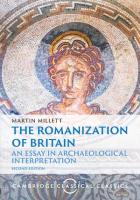
CUP (2nd ed., 2025) h/b 276pp £90 (ISBN 9781009485517)
Most students of Roman Britain are familiar with the first edition of The Romanization of Britain (ROB1), published in 1990. This second edition (ROB2) is identical to ROB1 except that there has been added a short foreword by Charlotte Higgins and a much longer introduction by Martin Millett.
Ms Higgins is the author of Under Another Sky, a delightful account of her journeys around Roman Britain. She sets the context for this book, reminding us that the title echoes the famous work by Francis Haverfield The Romanization of Roman Britain, published in 1912.
Much has happened in the century since Haverfield was writing, including two world wars, the collapse of the British Empire and a transformation in thinking about the ethics of imperialism. Haverfield saw Roman rule as a bastion against barbarism. As Higgins puts it, ‘Millett was utterly shorn of such illusions. His book …was for the postcolonial generation, rather than for colonial gentlemen.’
Millett’s introductory chapter provides a fascinating account of how scholarship in the field of Roman Britain has evolved during his lifetime. Up to the mid-twentieth century, the narrative was based on textual sources, with reference to archaeology where there were gaps in the available texts. Histories of Roman Britain were written from a colonialist perspective, for example Shepherd Frere’s Britannia (1967). Starting in the 1960s and 1970s, however, there was a burgeoning of fieldwork. Findings were discussed at weekend conferences. Archaeologists were now leading the way in Romano-British scholarship.
Martin Millett was part of this new movement. As a teenager in the late 1960s he took part in excavations. He went on to study at the Institute of Archaeology in the mid-1970s and thereafter to do doctoral research at Oxford. In the 1980s, as a lecturer in Roman Archaeology at Durham University he set about writing ROB1. His aims, as he explains, were to give sufficient weight to the archaeological evidence and to recentre the story on the indigenous peoples. He achieved those aims in full measure. The book is a mine of useful information with maps, tables, lists of towns, details of military sites and a wealth of social material. It includes much archaeological detail and analysis. The sub-title for the book is ‘An essay in archaeological interpretation’.
Following the publication of ROB1, there were debates about ‘Romanization’ through the 1990s. What did the term mean and was it a useful tool in historical analysis? Many scholars argue that the word has overtones of colonialism and is best avoided. It implies that the Roman occupiers imposed their culture on the local population, whereas in fact the interaction was a two-way process. Also, many of the occupying soldiers were not Romans at all: they were auxiliaries drawn from other provinces. Indeed, ‘Roman’ is hardly a uniform concept since the Roman world was regionally varied. Millett himself no longer uses the term ‘Romanization’, except—necessarily—in the title of ROB2.
During the 35 years since ROB1 was published there has been an explosion of archaeology, largely due to a change in planning laws which required proper investigation of sites before they could be developed. Also, research has become more diverse, with increasing use of botanical and animal bone evidence. Most works on Roman Britain now tend to be specialised. Good examples are the set of three volumes writing up the Roman Rural Settlement Project (2016 – 2018) and the 34 separate contributions in the Oxford Handbook of Roman Britain (2016), already reviewed by Classics for All. There have been very few overall accounts which present the available evidence in a postcolonial framework. The principal exception is David Mattingly’s book, An Imperial Possession: Britain in the Roman Empire (2006). The main emphasis in this book is on different groups of inhabitants within the general population. Roger Tomlin’s accounts of Roman Britain draw heavily on his expert knowledge of tablets recovered from Vindolanda, Bath and London. With the wealth of material now becoming available, Roman Britian is a fast-moving subject.
Despite all these recent developments, ROB1 is still a valuable resource. It is a distillation of the archaeological material that was available up to 1990. But it needs to be read with an introduction to set the work in context. ROB2 provides that. This second edition has much to offer any classicist, historian or archaeologist, who has a serious interest in Roman Britain.
Rupert Jackson
